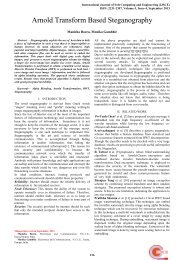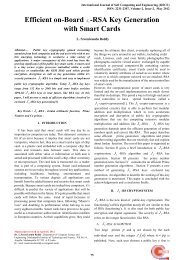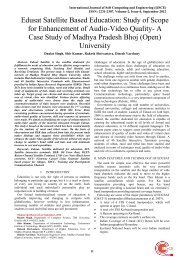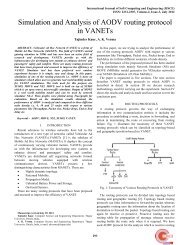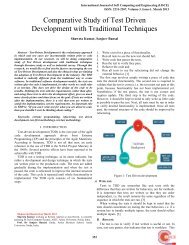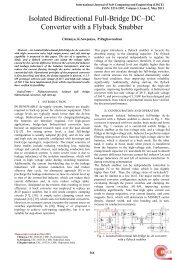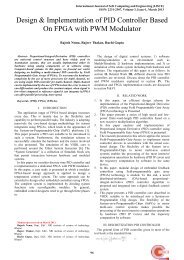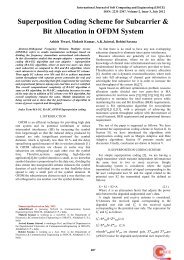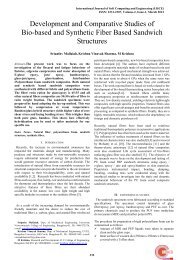<strong>An</strong> <strong>Improved</strong> <strong>Zone</strong> <strong>Based</strong> <strong>Hybrid</strong> <strong>Feature</strong> <strong>Extraction</strong> <strong>Model</strong> <strong>for</strong> Handwritten Alphabets Recognition Using EulerNumberaddition, 9 and 6 features are obtained by averaging thevalues placed in zones row-wise and column-wise,respectively. As result, every character is represented by 69,that is, 54 +15 features [1, 11]. These extracted features areused to train a feed <strong>for</strong>ward back propagation neural network<strong>for</strong> per<strong>for</strong>ming classification and recognition tasks.V. CLASSIFICATIONA feed <strong>for</strong>ward back propagation neural network havingtwo hidden layers with architecture of 69-100-100-26 is usedto per<strong>for</strong>m the classification. The hidden layers use logsigmoid activation function, and the output layer is acompetitive layer, as one of the characters is to be identified.The feature vector is denoted as p where p = (x1,x2,x3,.......xd)where x denotes features and d is the number of zones intowhich each character is divided. The number of input neuronsis determined by length of the feature vector d. The totalnumbers of characters t determines the number of neurons inthe output layer [6]. MLPs has to be so designed or framedthat the recognition system should be 50% faster than theindividual MLPs, while retaining the recognition rate at itshighest value.The network training parameters are:Input nodes: 69Hidden nodes: 100 eachOutput nodes: 26 (alphabets)Training Algorithm: Gradient Descent with MomentumTraining and Adaptive LearningPer<strong>for</strong>m function: Mean Square ErrorTraining Goal Achieved: 0.000001Training Epochs: 100000Training Momentum Constant: 0.9Training Learning Rate: 0.01VI. RESULT AND DISCUSSIONRecognition system has been implemented using Matlab7.5. The scanned image and the image drawn using paintapplication is given as an input to the feed <strong>for</strong>ward neural netarchitecture where it is first converted from .png to .tiff fileand then it is resized to a standard <strong>for</strong>mat of 60*90 pixelsimage followed by the thresholding/binarization operationwhich uses ‗otsu‘ algorithm to scaled it into 0 and 1 binaryimage.The structure of neural network includes an input layerwith 69 inputs including row wise and column wise features,two hidden layers each with 100 neurons and an output layerwith 26 neurons. The gradient descent back propagationmethod with momentum and adaptive learning rate andlog-sigmoid transfer functions is used <strong>for</strong> neural networktraining [1]. Neural network has been trained using knowndataset. A recognition system using two different features,one simple diagonal based feature and the other includes theEuler number. In both the cases size of feature vectors issame; the results obtained using these two different types offeature extraction are summarized in Table I & II.Table I. Recognition result/time elapsed obtained basedon diagonal based feature extractionAlphabetsDiagonal <strong>Based</strong> ResultA Recognised 0.4935B Recognised 0.7075D Recognised 0.6037E Recognised 0.6055P Recognised 1.4506Q Recognised 0.1766M Recognised 0.6070S Recognised 1.9696T Recognised 0.1781Y Recognised 1.9688Z Recognised 0.5088Elapsed Time (inseconds)Table II. Recognition result/time elapsed obtained basedon hybrid based feature extractionAlphabets <strong>Hybrid</strong> <strong>Based</strong> Result Elapsed Time (inseconds)A Recognised 0.4207B Recognised 0.1953D Recognised 0.5103E Recoginsed 0.1941P Recognised 0.2986Q Recognised 0.1941M Recognised 1.0355S Recognised 0.4055T Recognised 0.5103Y Recognised 0.1941Z Recognised 0.1721VII. CONCLUSIONA new type of feature extraction, namely, an efficientfeature extraction method is proposed which can give highrecognition accuracy while requiring less time <strong>for</strong> trainingand classification both as compare to the diagonal basedfeature extraction method which gives upto 98.5% accuracyrequiring less time <strong>for</strong> training [1]. The per<strong>for</strong>mance of thenetwork has been simulated using Matlab 7.5. To simplify theproject it has been restricted to few character sets. The507
constraints are posed to clear the concept behind new model.It can be said that the model is not a complete mechanism tocharacter recognition. The system per<strong>for</strong>ms very well duringclassification <strong>for</strong> these limited set of characters. It not onlyyields higher levels of recognition accuracy but the overalltime efficiency has increased as compared to the systemsemploying the diagonal based feature extraction [1] or anyother conventional methods of feature extraction.So, using the Euler Number computation which is good incategorizing the alphabets into different groups with zonebased feature extraction method will be effective processincreasing the accuracy and speed.International Journal of Soft Computing and Engineering (IJSCE)ISSN: 2231-2307, Volume-2, Issue-2, May 2012[16] N. Sharma, U. Pal, F. Kimura, "Recognition of Handwritten KannadaNumerals", 9th International Conference on In<strong>for</strong>mation Technology(ICIT'06), ICIT, pp. 133-136.[17] Ciar´ an ´ O Conaire, ―Efficient Euler-Number Thresholding‖, Centre<strong>for</strong> Digital Video Processing, Dublin City University, Ireland.[18] M Arijit Bishnu, Bhargab B. Bhattacharya, Malay K. Kundu b C.A.Murthy, Tinku Acharya, ―A pipeline architecture <strong>for</strong> computing theEuler number of a binary image‖, Journal of Systems Architecture 51(2005) 470–487.REFERENCES[1] J Pradeep, E Shrinivasan and S.Himavathi, ―Diagonal <strong>Based</strong> <strong>Feature</strong><strong>Extraction</strong> <strong>for</strong> Handwritten Alphabets Recognition System UsingNeural Network‖, International Journal of Computer Science &In<strong>for</strong>mation Technology (IJCSIT), vol . 3, No 1, Feb 2011.[2] M. Alata — M. Al-Shabi, ― Text Detection <strong>An</strong>d Character RecognitionUsing Fuzzy Image Processing‖, Journal of Electrical Engineering,vol. 57, no. 5, 2006, 258–267[3] R. Plamondon and S. N. Srihari, ―On-line and off- line handwrittencharacter recognition: A comprehensive survey,‖IEEE. Transactionson Pattern <strong>An</strong>alysis and Machine Intelligence, vol. 22, no. 1, pp. 63-84,2000.[4] N. Arica and F. Yarman-Vural, ―<strong>An</strong> Overview of CharacterRecognition Focused on Off-line Handwriting‖, IEEE Transactions onSystems, Man, and Cybernetics, Part C: Applications and Reviews,2001, 31(2), pp. 216 - 233.[5] U. Bhattacharya, and B. B. Chaudhuri, ―Handwritten numeraldatabases of Indian scripts and multistage recognition of mixednumerals,‖ IEEE Transaction on Pattern analysis and machineintelligence, vol.31, No.3, pp.444-457, 2009.[6] U. Pal, T. Wakabayashi and F. Kimura, ―Handwritten numeralrecognition of six popular scripts,‖ Ninth International conference onDocument <strong>An</strong>alysis and Recognition ICDAR 07, Vol.2, pp.749-753,2007.[7] Devinder Singh and Baljit Singh Khehra, ―Digit Recognition SystemUsing Back Propagation Neural Network‖, International Journal ofComputer Science and Communication Vol. 2, No. 1, January-June2011, pp. 197-205[8] VENTZAS, DIMITRIOS 1, NTOGAS, NIKOLAOS , ―ABINARIZATION ALGORITHM FOR HISTORICALMANUSCRIPTS‖, 12th WSEAS International conference onCommunications, Heraklion, Greece, July 23-25, 2008.[9] Bindu Philip, R. D. Sudhaker Samuel and C. R. Venugopal, Member,IACSIT, ―A Novel Segmentation Technique <strong>for</strong> Printed MalayalamCharacters‖, International Journal of Computer and ElectricalEngineering, Vol. 2, No. 4, August, 2010 1793-8163 PrintedMalayalam Characters.[10] <strong>An</strong>il Kumar Jain and Torfinn Taxt, ―<strong>Feature</strong> extraction Methods <strong>for</strong>Character Recognition- A Survey‖, Pattern Recognition, Vol.29, No.4,pp. 641-662, 1996.[11] S.V. Rajashekararadhya, and P.VanajaRanjan, ―Efficient zone basedfeature extraction algorithm <strong>for</strong> handwritten numeral recognition offour popular south-Indian scripts,‖ Journal of Theoretical and AppliedIn<strong>for</strong>mation Technology, JATIT vol.4, no.12, pp.1171-1181, 2008.[12] <strong>An</strong>ita Pal & Dayashankar Singh, ― Handwritten English CharacterRecognition Using Neural Network‖, International Journal ofComputer Science & Communication‖, Vol. 1, No.2, July-December2010, pp. 141-144[13] G. Vamvakas, B. Gatos, I. Pratikakis, N. Stamatopoulos, A. Roniotis,S.J. Perantonis, "<strong>Hybrid</strong> Off-Line OCR <strong>for</strong> Isolated Handwritten GreekCharacters", The Fourth IASTED International Conference on SignalProcessing, Pattern Recognition and Applications (SPPRA‘07), pp.197-202, Innsbruck, Austria, February 2007.[14] G. Vamvakas, B. Gatos, S. Petridis and N. Stamatopoulos, ''<strong>An</strong>Efficient <strong>Feature</strong> <strong>Extraction</strong> and Dimensionality Reduction Scheme <strong>for</strong>Isolated Greek Handwritten Character Recognition'', Proceedings ofthe 9th International Conference on Document <strong>An</strong>alysis andRecognition, Curitiba, Brazil, 2007, pp. 1073-1077.[15] Dinesh Acharya U, N V Subba Reddy and Krishnamurthy, ―Isolatedhandwritten Kannada numeral recognition using structural feature andK-means cluster,‖ IISN-2007, pp-125 -129.508



